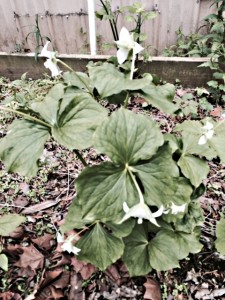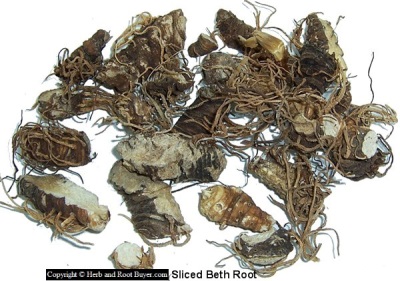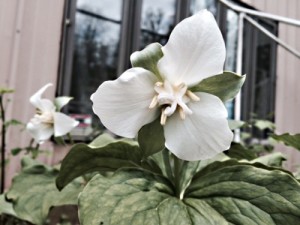Beth Root – Trillium erectum
|
Current Demand = Normal |
Parts Used: Rhizome and Root |
 |
Family: Liliaceae
Common names: birth root, wake robin, nodding wakerobin, Indian shamrock, lamb’s quarters, Indian balm, ground lily, cough root, Jew’s harp plant, milk ipecac, Pariswort, rattlesnake root, snakebite, three-leaved nightshade, red trillium, stinking Benjamin..
Family: Liliaceae
Common names: birth root, wake robin, nodding wakerobin, Indian shamrock, lamb’s quarters, Indian balm, ground lily, cough root, Jew’s harp plant, milk ipecac, Pariswort, rattlesnake root, snakebite, three-leaved nightshade, trillium
Description Beth root is a herbaceous perennial which grows in rich soils and shady woods of the central and western United States and grows to a height of 40cm. The simple stem arises from an oblong, tuberous rootstock and bears at the top a whorl of three round-ovate acuminate leaves. In May and June a single yellow-white to reddish-white flower appears above the leaves. The scented flowers are hermaphrodite (have male and female organs) and are pollinated by flies. Beth root is a stout erect perennial herb with a simple stem bearing a whorl of three broad rhombic pointed leaves and terminating in a large terminal flower with six petals, purple, pale green or pale brown. It prefers light (sandy), medium (loamy) and heavy (clay) soils and requires a well drained soil. Growing region: Beth root can be found in the Eastern United States and Canada. It is common thru-out the Midwest and Appalachia, west to Missouri and south to Arkansas. An abundance of Beth root can be found in Kentucky, Indiana, Tennessee and Ohio.
Harvesting/Drying
Parts Used: rhizome and root For maximum potency Beth root should be harvested in late summer and fall after it has time to seed. Only the plants roots have medicinal properties and market value. Gather the larger more mature plants leaving plenty of younger smaller plants to seed the area for future harvest. After harvest, the roots should be washed in cold water and foreign material (rocks, dirt and other roots) must be removed. Unless your buyer is purchasing fresh dug roots (which they often do) the clean roots need to be dried. Large roots will need to be sliced in half to allow drying. Beth root is very difficult to dry without slicing into pieces. Beth root can be dried in the sun although if possible dry indoors in a well ventilated barn loft or attic to protect it from the elements. If natural heat is not available you may need to add heat and a fan for continuous airflow. The key to drying any root, herb or bark in an even combination of heat and airflow. Never use an oven or microwave.Beth root will be completely dry (largest stem will snap not bend) in 5-8 days depending on the size of the root and the drying conditions. Place the root carefully into a cardboard box or paper bag for storage in a dry area until you are ready to sell or use. Do not store the roots in plastic or it will mold.
For maximum potency Beth root should be harvested in late summer and fall after it has time to seed. Only the plants roots have medicinal properties and market value. Gather the larger more mature plants leaving plenty of younger smaller plants to seed the area for future harvest. After harvest, the roots should be washed in cold water and foreign material (rocks, dirt and other roots) must be removed. Unless your buyer is purchasing fresh dug roots (which they often do) the clean roots need to be dried. Large roots will need to be sliced in half to allow drying. Beth root is very difficult to dry without slicing into pieces. Beth root can be dried in the sun although if possible dry indoors in a well ventilated barn loft or attic to protect it from the elements. If natural heat is not available you may need to add heat and a fan for continuous airflow. The key to drying any root, herb or bark in an even combination of heat and airflow. Never use an oven or microwave.Beth root will be completely dry (largest stem will snap not bend) in 5-8 days depending on the size of the root and the drying conditions. Place the root carefully into a cardboard box or paper bag for storage in a dry area until you are ready to sell or use. Do not store the roots in plastic or it will mold.
Taste/smell: Earthy smell and taste, slightly acrid.The root is harvested in late summer or early autumn, after the leaves have died down and is dried to be used later.
Planting:Cultivation details Beth Root prefers deep well-drained woodland or humus-rich soil in a somewhat shady position that remains moist in the summer. It can grow in shade, semi-shade or no shade. It is a hardy plant, tolerating temperatures down to -35 degree Celsius. The plants are rarely troubled by deer or rabbits. The flower has a putrefied flesh and the white flower is almost scentless. The plants can flower in two years from seeds.Stored seeds should be sown in late winter or early spring. The seed germinates within 1-3 weeks. The reports indicate the plant will have a root after the first cold stratification but no shoots are produced until the second year. Some reports indicate it takes 3 years to develop shoots. Young plants should be cold-framed for the first year over the winter period. It is important to keep the pots damp but not wet or dry. After the flowering season, the plants can be divided with care. The larger portions can be planted directly into their permanent placement. The smaller parts do very well in small pots placed in light shade. They can then be planted the following spring.
 Root Buyer
Root Buyer